
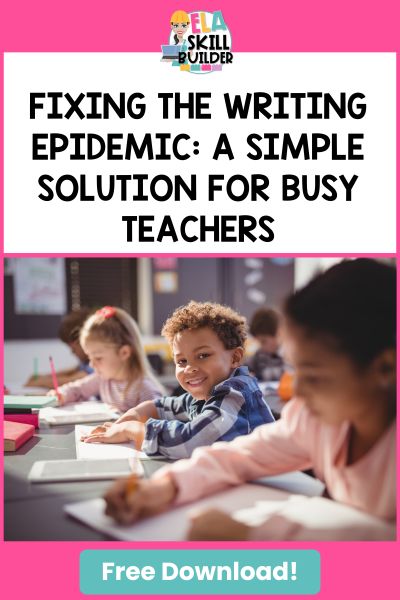
Fixing the Writing Epidemic: A Simple Solution for Busy Teachers
According to the most recent national assessments, just 27% of students in the United States perform at the proficient level or above in writing. That’s a wake-up call. As educators, we’ve seen a strong push for phonics and reading, but writing? It’s often left behind.
This post is for elementary teachers who care deeply about literacy and want to better support young writers, even if writing instruction has felt overwhelming, confusing, or like there’s simply no time for it in the school day.
Let’s talk about why writing is being overlooked, why it still matters (even in the age of AI), and how you can start making it part of your classroom routine right away – without adding more to your plate.
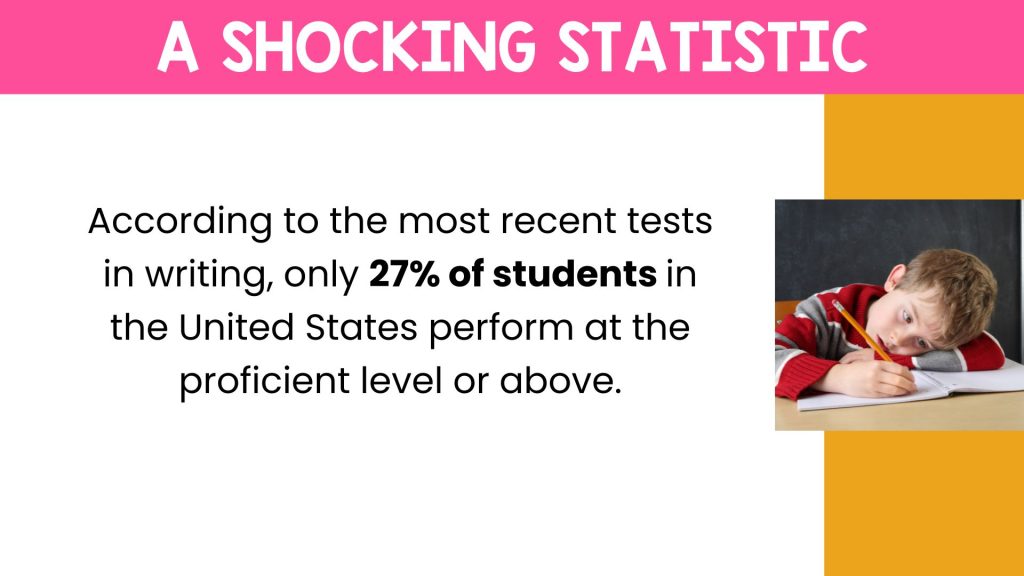
Why Writing Is Still Relevant
Even with tools like ChatGPT and other AI writing helpers, writing instruction still matters a lot. These tools can be useful, but they don’t replace the thinking, creativity, and communication that come from writing. If we let students skip over that process, we take away important learning opportunities. Writing builds skills they’ll use for the rest of their lives.
Here are a few reasons why writing instruction must remain a top priority:
- Creativity
Writing gives students a space to express their own ideas and imagination. AI can generate content, but it doesn’t have personal experiences or emotions. Writing helps students dream, create, and make meaning from their own perspective. - Communication
Writing teaches students how to express their thoughts clearly and effectively. Whether it’s a story, an explanation, or an email, strong writing builds strong communication – a skill they’ll use in school, work, and life. - Syntax and Structure
Writing helps students internalize grammar, sentence construction, and overall language structure. The more they write, the more confident they become in using language accurately in both written and spoken form. - Critical Thinking
Writing makes students think. They have to organize ideas, make connections, and explain their reasoning. This kind of processing builds deeper understanding and helps students become better learners across all subjects. - Preparation
Writing is essential for academic success and professional readiness. From essays and reports to resumes and job applications, students need writing skills to function and thrive in the real world. - Reading Support
Writing supports reading comprehension. When students write about what they’ve read, they’re more likely to understand and retain the information. It also gives teachers a window into students’ thinking.
Bottom line:
If we stop teaching writing, we limit our students’ ability to think critically, communicate clearly, and succeed in school and beyond. Writing is a non-negotiable.
Why Teachers Struggle with Teaching Writing
So we know that writing instruction continues to be very important in our elementary classroms, yet so many teachers struggle with it in their classrooms.
Why do so many teachers struggle with writing instruction? There are 2 main challenges that teachers face:
Challenge #1: Lack of Teacher Training
In fact, 3 out of 4 third and fourth grade teachers say their college teacher prep programs gave them minimal or no instruction on how to teach writing.
I can relate to that. I still remember learning all about how to teach reading and math in college. But teaching writing? That part was barely mentioned. When I started my first year of teaching, I felt totally unprepared to support my students as writers. And I know I’m not alone.
On top of that, writing often gets pushed aside in schools. With the rise of the Science of Reading, there’s been a major focus on phonics and decoding – which is great! But it’s led to writing being treated like an afterthought.
Even many of the big-box literacy curriculums that schools are adopting offer very little support for explicit writing instruction. So even when teachers want to teach writing, the materials just aren’t there.
Challenge #2: Lack of Time
Elementary classrooms are packed with lessons, transitions, behavior management, small groups, and testing. Teachers are under pressure to fit everything in, and writing often falls to the bottom of the priority list.
A lot of teachers feel like they need a big, dedicated writing block every day to do it “right.” But with so many competing demands, that kind of time just doesn’t exist in most classrooms.
So instead of carving out a spot for writing, it gets skipped, or when it is assigned, it’s not always explicitly taught.
This quote sums it up well:
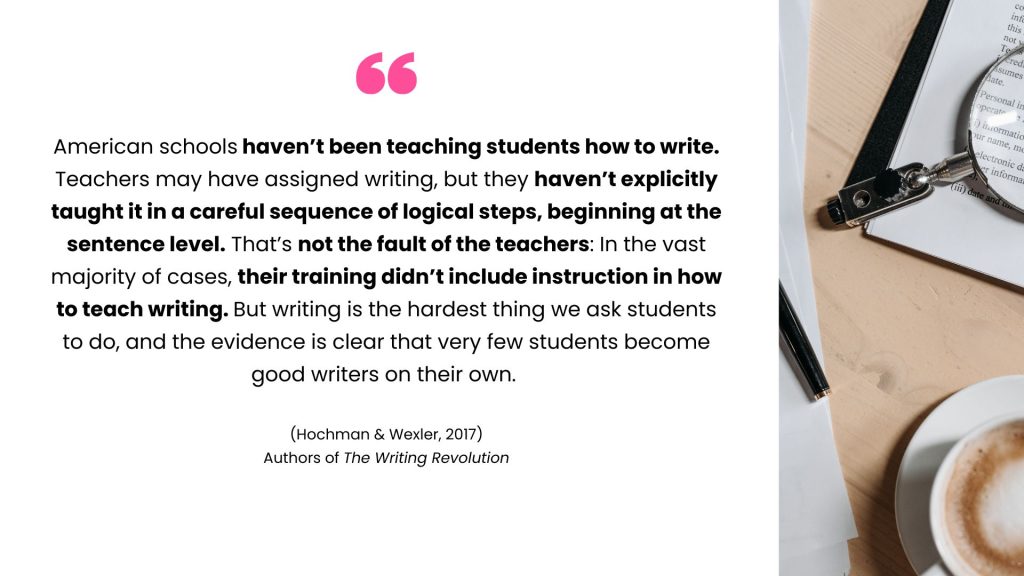
A Simple Solution: Embedding Writing in All Subjects
Many teachers want to teach writing effectively, but there are some common challenges – limited training, overwhelming curriculums, and packed schedules.
With so much to fit into the school day, carving out a big block of time for writing instruction can feel unrealistic. The good news is that you don’t have to.
Research shows that embedding writing into content areas like ELA, science, social studies, and even math not only improves writing skills but also deepens students’ understanding of the subject matter. It’s an efficient and effective way to teach writing.
Simple, targeted sentence and paragraph activities can make a big difference without requiring a dedicated writing block.
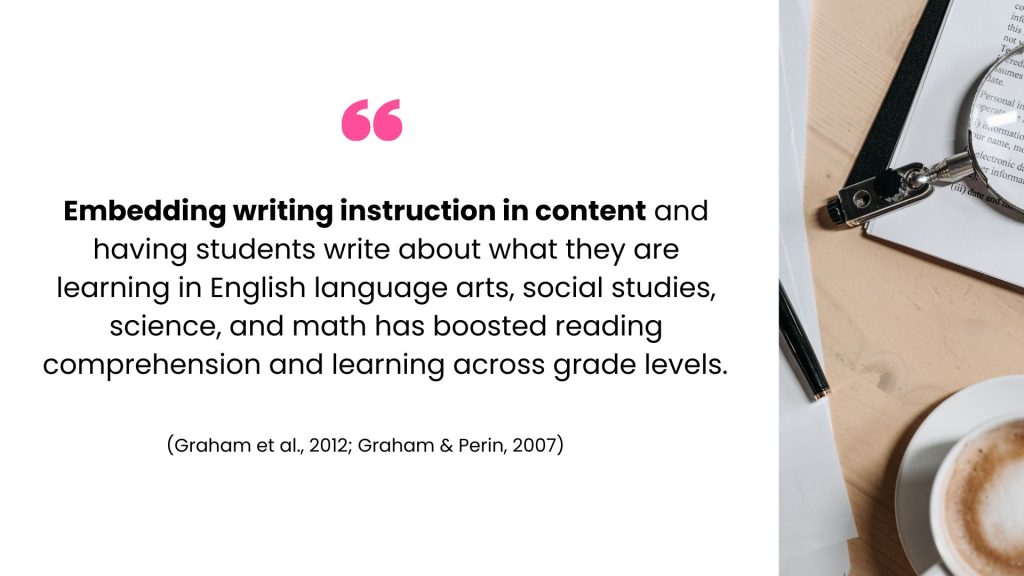
Start with Sentence Writing
We often place high expectations on students when it comes to writing, which can lead to overwhelm and a lack of confidence. Instead of expecting perfect essays right away, it’s important to start small and focus on the basics.
Research shows that writing instruction should begin at the sentence level. This approach helps students build a strong foundation and gradually gain confidence in their writing.
Here are some reasons why starting with sentence writing is so important:
Reducing Cognitive Overload
Focusing on sentence writing helps students reduce cognitive overload. They don’t have to worry about crafting entire essays – just well-constructed sentences, making writing more manageable.
Mastering Key Writing Structures
Sentence-level instruction lets students master important structures like appositives, conjunctions, and complex sentences. These elements form the foundation for more sophisticated writing as students progress.
Building Confidence
When students master sentence writing, they gain confidence in their ability to write. Small wins with sentence construction motivate them to tackle bigger writing tasks with more self-assurance.
Preparing for More Complex Writing
Once students are comfortable writing strong sentences, they’re ready to move on to paragraphs and essays. With a solid foundation in place, they’re prepared to take on more complex writing challenges.
Starting with sentence writing sets students up for success and helps them become confident, capable writers.
Here is an example of a ‘Sentence Expansion’ activity completed by a second-grader after reading the book ‘A Hen for Izzy Pippik’:

Try This: Sentence Expansion Activity
One of my favorite activities for building sentence skills is Sentence Expansion. It teaches students how to take a basic sentence and add detail, structure, and clarity.
Grab the free sentence expansion lesson here.
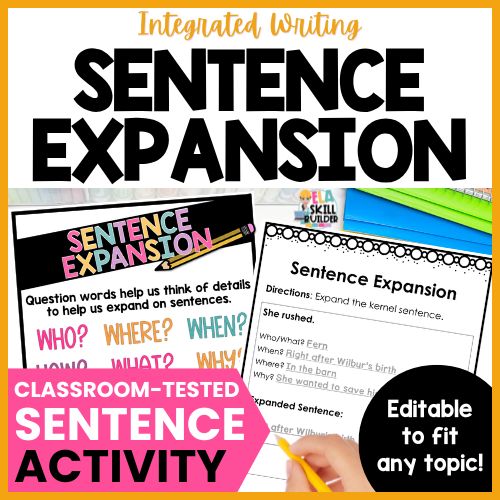
Move into Paragraph Writing
Once students are comfortable with sentence writing, it’s time to build on that foundation with paragraph writing. Paragraph writing gives students the opportunity to organize their thoughts more clearly and express ideas in greater detail. Instead of just focusing on individual sentences, students start to see how their ideas connect and flow together.
Here’s why paragraph writing is so important:
Organizing Ideas
Paragraph writing helps students organize their ideas logically. They learn to group related thoughts together, creating a more cohesive piece of writing.
Separating Main Ideas from Supporting Details
In paragraph writing, students learn to clearly distinguish between the main idea and supporting details. This skill helps them stay focused and present information in an easy-to-understand way.
Following a Clear Structure
Paragraphs have a clear structure with a beginning, middle, and end. This structure gives students a roadmap for organizing their writing, making it easier to craft well-structured pieces.
Preparing for Longer Writing Tasks
As students apply what they’ve learned about sentences to paragraphs, you’ll notice a significant improvement in their writing. This skill is the bridge to even longer, more complex writing tasks like essays.
Paragraph writing builds on the sentence-writing skills students have mastered and sets them up for even greater writing success.
Here is an example of a single-paragraph outline completed by a second grader after a science lesson on the water cycle.
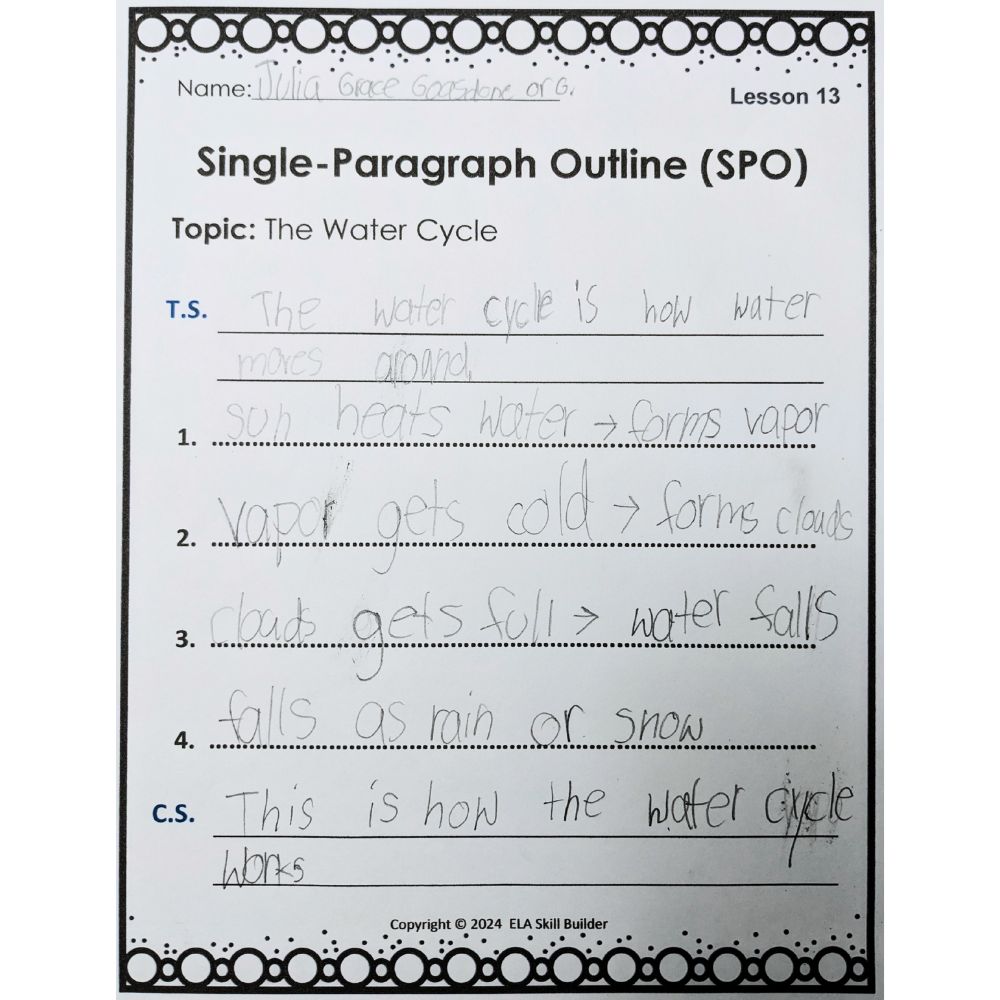
– Distinguishing the main idea from supporting details
– Writing strong topic and closing sentences
– Using note-taking strategies to develop supporting details
Conclusion
Despite the challenges we face in the elementary classroom, there is a simple solution we can start using right away: integrating writing into other subject areas.
By embedding writing activities in subjects like English language arts, social studies, science, and math, we not only reinforce writing skills, but we also deepen students’ understanding of the content. It’s a win-win! Students become stronger writers while simultaneously building their knowledge in other areas.
Free Pacing Guide
To make this process easier, I’ve created a FREE pacing guide that outlines 30 sentence, paragraph, and revising activities to help your students become successful writers. These activities are flexible and can be repeated as needed.
Just remember: don’t move into paragraph or revising activities until your students have a solid grasp of sentence writing. Once they’re ready, you’ll see their writing skills soar.
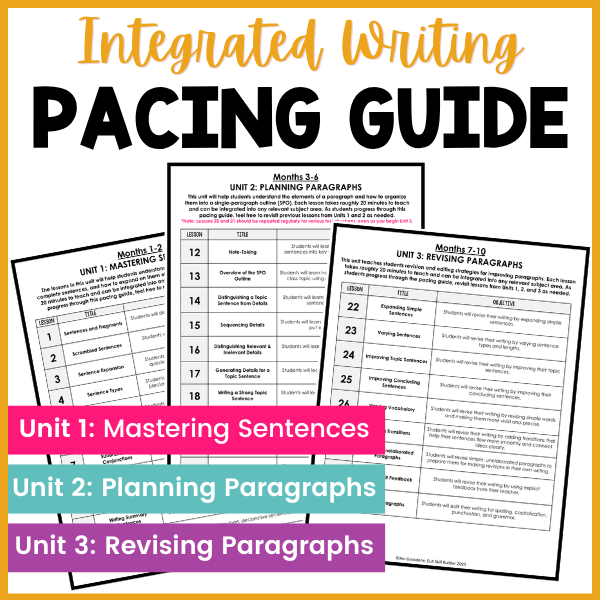
About Jen Goasdone
Jen Goasdone, the owner of ELA Skill Builder, is a dedicated educator committed to empowering teachers with simple, research-based strategies for effective writing instruction. With a focus on making ELA teaching easier and more impactful, Jen helps students build a strong writing foundation that will serve them for years to come. Passionate about both teacher and student success, she strives to make writing instruction enjoyable and effective for elementary students.
Related Posts


Hey Teachers,
I'm Jen from ELA Skill Builder!
My mission is to help you be the best ELA teacher you can be by providing simple and creative ideas that will boost student engagement and skill mastery in your classroom.
Best Sellers!
coupon code
Get 15% off Your First Purchase
free lessons!
community
join the waitlist
Revamp your writing class!
Best Sellers!
free routine!
coupon code
Get 15% off Your First Purchase

Hey Teachers,
I'm Jen from ELA Skill Builder!
My mission is to help you be the best ELA teacher you can be by providing simple and creative ideas that will boost student engagement and skill mastery in your classroom.









